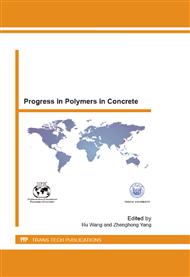p.322
p.329
p.335
p.341
p.347
p.354
p.359
p.369
p.378
Dispersion and Absorption of SBR Latex in the System of Mono-Dispersed Cement Particles in Water
Abstract:
This paper investigates the dispersion of cement particles in water at different mix proportions using optical microscope, and the dispersion and absorption of SBR latex in the system of mono-dispersed cement particles in water using environmental scanning electron microscope (ESEM). The results show that the mono-dispersed cement can be well obtained at the water to cement ratio (mw/mc) of 10:1. The ESEM images present that SBR latex is dispersed on the surface of the cement particles as well as the solution phase. SBR latex does not prefer to be absorbed on the cement particles in spite of their opposite electric charge but chooses to be dispersed in the system proportionally. In addition, SBR particles are single-layer absorbed on the surface of cement particles in all the SBR latex to cement ratios (mp/mc). Several SBR particles absorbed on the surface of cement particle get close enough to form groups at the mp/mc of 15% and 20%. The results of this paper provide some bases for analyzing the influence of polymer on cement hydration and the microstructure formation of polymer-modified cement-based materials in a new view.
Info:
Periodical:
Pages:
347-353
Citation:
Online since:
April 2013
Authors:
Price:
Сopyright:
© 2013 Trans Tech Publications Ltd. All Rights Reserved
Share:
Citation:


